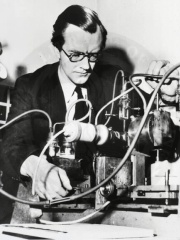

The Most Famous
PHYSICISTS from New Zealand
This page contains a list of the greatest New Zealander Physicists. The pantheon dataset contains 851 Physicists, 2 of which were born in New Zealand. This makes New Zealand the birth place of the 35th most number of Physicists behind Iran, and Mexico.
Top 2
The following people are considered by Pantheon to be the most legendary New Zealander Physicists of all time. This list of famous New Zealander Physicists is sorted by HPI (Historical Popularity Index), a metric that aggregates information on a biography's online popularity.

1. Ernest Rutherford (1871 - 1937)
With an HPI of 83.66, Ernest Rutherford is the most famous New Zealander Physicist. His biography has been translated into 139 different languages on wikipedia.
Ernest Rutherford, Baron Rutherford of Nelson (30 August 1871 – 19 October 1937), was a New Zealand physicist and chemist who was a pioneering researcher in both atomic and nuclear physics. He has been described as "the father of nuclear physics" and "the greatest experimentalist since Michael Faraday." In 1908, he was awarded the Nobel Prize in Chemistry "for his investigations into the disintegration of the elements, and the chemistry of radioactive substances." He was the first Oceanian Nobel laureate, and the first to perform Nobel-awarded work in Canada. Rutherford's discoveries include the concept of radioactive half-life, the radioactive element radon, and the differentiation and naming of alpha and beta radiation. Together with Thomas Royds, Rutherford is credited with proving that alpha radiation is composed of helium nuclei. In 1911, he theorised that atoms have their charge concentrated in a very small nucleus. He arrived at this theory through his discovery and interpretation of Rutherford scattering during the gold foil experiment performed by Hans Geiger and Ernest Marsden. In 1912, he invited Niels Bohr to join his lab, leading to the Bohr model of the atom. In 1917, he performed the first artificially induced nuclear reaction by conducting experiments in which nitrogen nuclei were bombarded with alpha particles. These experiments led him to discover the emission of a subatomic particle that he initially called the "hydrogen atom", but later (more precisely) renamed the proton. He is also credited with developing the atomic numbering system alongside Henry Moseley. His other achievements include advancing the fields of radio communications and ultrasound technology. Rutherford became Director of the Cavendish Laboratory at the University of Cambridge in 1919. Under his leadership, the neutron was discovered by James Chadwick in 1932. In the same year, the first controlled experiment to split the nucleus was performed by John Cockcroft and Ernest Walton, working under his direction. In honour of his scientific advancements, Rutherford was recognised as a baron of the United Kingdom. After his death in 1937, he was buried in Westminster Abbey near Charles Darwin and Isaac Newton. The chemical element rutherfordium (104Rf) was named after him in 1997.

2. Maurice Wilkins (1916 - 2004)
With an HPI of 71.61, Maurice Wilkins is the 2nd most famous New Zealander Physicist. His biography has been translated into 69 different languages.
Maurice Hugh Frederick Wilkins (15 December 1916 – 5 October 2004) was a New Zealand-born British biophysicist and Nobel laureate whose research spanned multiple areas of physics and biophysics, contributing to the scientific understanding of phosphorescence, isotope separation, optical microscopy, and X-ray diffraction. He is most noted for initiating and leading early X-ray diffraction studies on DNA at King's College London, and for his pivotal role in enabling the discovery of the double helix structure of DNA. Wilkins began investigating nucleic acids in 1948. By 1950, he and his team had produced some of the first high-quality X-ray diffraction images of DNA fibers. He presented this work in 1951 at a conference in Naples, where it significantly influenced James Watson, prompting Watson to pursue DNA structure research with Francis Crick. In 1951, Rosalind Franklin joined King’s College and was assigned to the same DNA project, though without a clear delineation of leadership. Tensions developed due to overlapping roles and lack of administrative clarity. During this period, Franklin and graduate student Raymond Gosling captured the high-resolution Photo 51, a diffraction image of B-form DNA. In early 1953, John Randall instructed Gosling to hand it over to Wilkins. Wilkins, in turn, showed it to Watson—without Franklin's consent. This action has been the subject of significant ethical and historiographical debate. Using insights from Photo 51 and prior data—including Wilkins' own diffraction studies—Watson and Crick constructed their double helix model in March 1953. Wilkins simultaneously continued experimental validation, producing confirmatory diffraction images published in the same issue of Nature. Wilkins' contributions were not limited to verification. He had led the DNA diffraction research at King’s before Franklin’s arrival, initiated the methods that led to Photo 51, and played a central role in sharing data and coordinating the laboratory’s DNA efforts—roles often underrepresented in historical summaries. In later years, Wilkins extended his studies to RNA structure and worked on the biological effects of radiation. He shared the 1962 Nobel Prize for Physiology or Medicine with Watson and Crick, awarded "for their discoveries concerning the molecular structure of nucleic acids and its significance for information transfer in living material". Although Franklin had died in 1958 and was therefore ineligible, Wilkins acknowledged her work in his writings and interviews. In 2000, King's College London named one of its science buildings the Franklin-Wilkins Building to honor their contributions. Scholarly reassessments in recent decades have increasingly recognized Wilkins’ role as foundational to the DNA discovery effort.
People
Pantheon has 2 people classified as New Zealander physicists born between 1871 and 1916. Of these 2, none of them are still alive today. The most famous deceased New Zealander physicists include Ernest Rutherford, and Maurice Wilkins.

